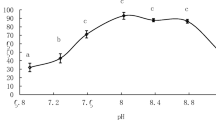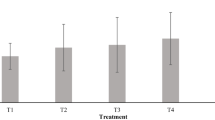Abstract
Young of Tilapia nilotica L. were subjected to acidic and alkaline media of different pH over 24 h periods. Dilute hydrochloric acid was used to lower the hydrogen ion concentration of the test medium. A pH lower than 2.9 resulted in immediate mortality, whereas a pH of 3.5 and above produced no mortality. Alkaline media had no serious effect on survival.
Similar content being viewed by others
Literature Cited
Alexander, G. R. and D. S. Shetter: Seasonal mortality and growth of hatchery-reared brook and rainbow trout in east fish lake, Montmorency County, Michigan, 1958–59. Mich. Acad. Sci. 56, 317–328 (1961).
American Public Health Association, American Water Works Association and Water Pollution Control Federation: Standard methods for examination of water and waste water including bottom sediments and sludges, 626 pp. New York: American Public Health Association 1960.
Belding, D. L.: Toxicity experiments with fish in reference to trade waste pollution. Trans. Am. Fish. Soc. 57, 100–119 (1927).
Berry, L.: The characteristics and mode of formation of Nile islands between Malakal and Sabaloka. Rep. hydrobiol. Res. Unit Univ. Khartoum 8, 7–13 (1960/1961a).
—: The physical history and development of the White Nile. Rep. hydrobiol. Res. Unit Univ. Khartoum 8, 14–19 (1960/1961b).
Bishai, H. M.: The effect of the water hyacinth, Eichhornia crassipes, on the fisheries of the Sudan. Rep. hydrobiol. Res. Unit Univ. Khartoum 8, 29–36 (1960/1961).
—: The effect of pressure on the distribution of some Nile fish. J. exp. Zool. 147, 113–124 (1961).
—: The water characteristics of the Nile in the Sudan with a note on the effect of Eichhornia crassipes, on the hydrobiology of the Nile. Hydrobilogia 19, 357–382 (1962).
—: Resistance of Tilapia nilotica L. to high temperatures. Hydrobiologia 25, 473–488 (1965).
Boulenger, G. A.: Zoology of Egypt. The fishes of the Nile, London: Hugh Rees Ltd. 1907.
Chadwick, M. J.: Some observations on the ecology of Eichhornia crassipes Solms. Rep. hydrobiol. Res. Unit Univ. Khartoum 8, 23–26 (1960/1961).
Clark, H. W. and G. O. Adams: Studies on fish life and water pollution. Rep. Mass. Bd Hlth. 44, 336–345 (1913).
Creaser, C. W.: Relative importance of hydrogen-ion concentration, temperature, dissolved oxygen and carbon dioxide tension on habitat selection by brook trout. Ecology 11, 246–262 (1930).
Daugherty, A. M. and L. C. Altman: Influence of hydrogen ion concentration, salinity and oxygen upon the rheotaxis of some marine fish. Publs Puget Sound mar. biol. Stn 3, 365–368 (1925).
Douglas, N. H. and W. H. Irwin: Evaluation and relative resistance of sixteen species of fish as test animals in toxicity bioassays of petroleum refinery effluents. Mimeogr. Oklahoma State University, Department of Zoology, Contribution 351 (1962).
Ellis, M. M.: Detection and measurement of stream pollution. Bull. Bur. Fish., Wash. 48, 365–437 (1937).
Foy, R. E. and M. Scott: Effects of pressure on survival of six species of fish. Trans. Am. Fish. Soc. 94, 88–91 (1965).
Fraenkel, G.: Lethal high temperatures for three marine invertebrates: Limulus polyphemus, Littorina littorea and Pagurus longicarpus. Oikos (1960).
Gay, P. A.: Some aspects of the riverain flora of the White Nile and Bahr El-Ghazal. Rep. hydrobiol. Res. Unit Univ. Khartoum 4, 10–20 (1956/1957).
—: Eichhornia crassipes in the Nile of the Sudan. Nature, Lond. 182, 538–539 (1958).
Halwagy, R.: Studies on the succession of vegetation on some islands and sand bars in the Nile near Khartoum. Rep. hydrobiol. Res. Unit Univ. Khartoum 8, 20–22 (1960/1961).
Henderson, C., Q. H. Pickering and C. H. Tarzwell: Relative toxicity of ten chlorinated hydrocarbon insecticides to four species of fish. Trans. Am. Fish. Soc. 88, 23–32 (1959).
Hickling, C. F.: Fish culture, 295 pp. London: Faber & Faber 1962.
Jewell, M. E. and H. W. Brown: Fishes of an acid lake. Trans. Am. microsc. Soc. 43, 77–84 (1924).
Kelley, A. M.: Effect of abnormal CO2 tension on development of herring eggs. J. Fish. Res. Bd Can. 6, 435–440 (1946).
Kelly, H. D.: Preliminary studies on Tilapia mossambica Peters relative to experimental pond culture. Proc. A. Conf. S.E. Ass. Game and Fish Comm. 10, 139–149 (1956).
King, J. E.: Survival time of trout in relation to occurrence. Am. Midl. Nat. 29, 624–642 (1943).
Krishna, D.: Effect of changing pH on developing trout eggs and larvae. Nature, Lond. 171, p. 434 (1953).
Lagler, K. F.: Freshwater fishery biology, 421 pp. Dubuque, Iowa: Wm.C. Brown Co. 1961.
Mahdi, M. A.: Mortality of some species of fish to toxaphene at three temperatures. U.S. Bur. Sport Fish. Wildl. Invest. Fish control 6, 1–10 (1966).
—: Studies on factors affecting survival of Nile fish in the Sudan. III. The effect of oxygen. Mar. Biol. 18, 96–98 (1973).
— and M. A. Amin: An attempt to control bilharziasis by fish. Hydrobiologia 28, 66–72 (1966).
Menzies, W. J. M.: River pollution and the acidity of natural waters. Nature, Lond. 119, 638–639 (1927).
Nawar, G.: Preliminary investigations on breeding times of some Nile fishes. Rep. hydrobiol. Res. Unit Univ. Khartoum 4, 24–27 (1956/1957).
Pekkola, W.: Seasonal occurrence and edibility of fish at Khartoum. Sudan Notes Rec. 1, 88–98 (1918).
—: Notes on the habits, breeding and food of some White Nile Fishes. Sudan Notes Rec. 2, 112–121 (1919).
Prowse, G. A.: Phytoplankton. Rep. hydrobiol Res. Unit Univ. Khartoum 1, 12–14 (1953/1954).
—: Phytoplankton. Rep. hydrobiol. Res. Unit Univ. Khartoum 2, 10–11 (1954/1955).
Rounsefell, G. A. and W. H. Everhart: Fishery science, its methods and applications, 444 pp. New York: John Wiley & Sons, 1960.
Rzoska, J.: Observations on tropical rainpools and general remarks on temporary waters. Hydrobiologia 17, 265–286 (1961).
Sanborn, N. H.: The lethal effect of certain chemicals on fresh water fish. Cann. Trade 67 (49), 10–12 (1945).
Sandon, H.: An illustrated guide to the freshwater fishes of the Sudan. Sudan Notes Rec. 1–61 (1950).
Shelford, V. E. and W. C. Allee: The reaction of fishes to gradients of dissolved atmospheric gases. J. exp. Zool. 14, 207–266 (1913).
—: Rapid modification of the behaviour of fishes by contact with modified water. J. Anim. Behav. 4, 1–31 (1914).
Swingle, H. S.: Relationship of pH of pond waters to their suitability for fish culture. Proc. pan.-Pacif. Sci. Congr. (9, Bangkok, Thailand) 10, 72–75 (1957).
Talling, J. F.: Chemical and physical characteristics of Nile waters in relation to phytoplankton production. Rep. hydrobiol. Res. Unit Univ. Khartoum 1, 10–12 (1953/1954).
—: Water characteristics and phytoplankton production. Rep. hydrobiol. Res. Unit Univ. Khartoum 3, 8–12 (1955/1956).
—: Some physical, chemical and algological aspects of Nile hydrobiology. Rep. hydrobiol. Res. Unit Univ. Khartoum 4, 6–8 (1956/1957).
—: the longitudinal succession of water characteristics in the White Nile. Hydrobiologia 11, 73–89 (1957).
Van Horn, W. M., J. B. Anderson and M. Katz: The effect of craft pulp mill wastes on some aquatic organisms. Trans. Am. Fish. Soc. 79, 55–63 (1950).
Wells, M. M.: The reactions and resistance of fishes in their natural environment to salts. J. exp. Zool. 19, 243–283 (1915).
Wiebe, A. H.: Notes on the exposure of several species of pond fishes to sudden changes in pH. Trans Am. microsc. Soc. 50, 380–393 (1931a).
—: Notes on the exposure of several species of fish to sudden changes in the hydrogen-ion concentration of the water and to an atmosphere of pure oxygen. Trans. Am. Fish. Soc. 61, 216–224 (1931b).
Author information
Authors and Affiliations
Additional information
Communicated by O. Kinne, Hamburg
Rights and permissions
About this article
Cite this article
Mahdi, M.A. Studies on factors affecting survival of nile fish in the Sudan. I. The effect of hydrogen ion concentration. Marine Biology 18, 89–92 (1973). https://doi.org/10.1007/BF00348682
Accepted:
Issue Date:
DOI: https://doi.org/10.1007/BF00348682




